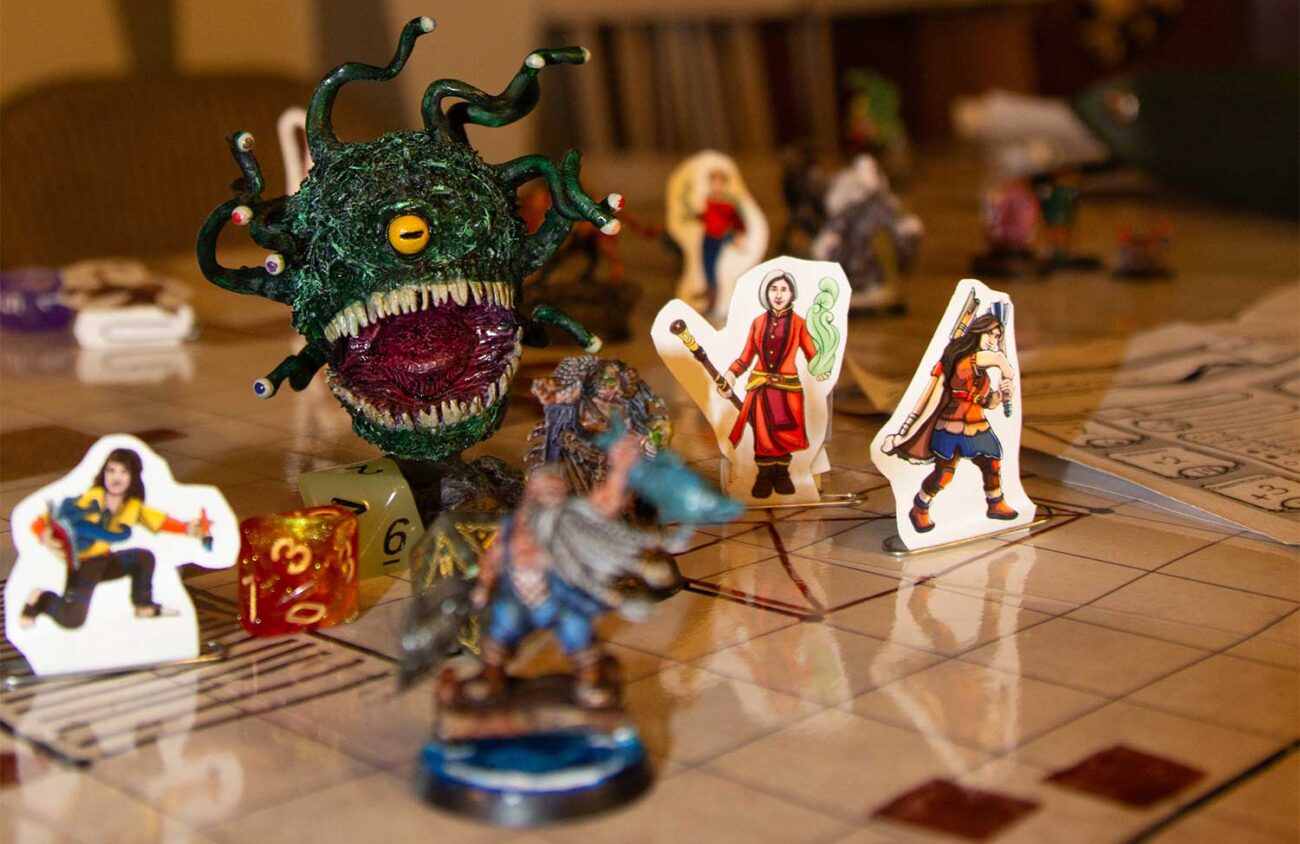By Emma J Nelson and McKenzie Young-Roy
There are few activities that transcend religion, politics and culture. Storytelling, which walks hand-in-hand with language, bridges those gaps.
Storytelling is more than literature; it’s conversation, it’s education, it’s the intrinsic human need to share.
“Not every story is a great work of art,” says Michelle Sugiyama. “Narrative is just one of the primary means that we use to communicate with others.”
Sugiyama, a University of Oregon anthropology professor, researches the origins of art, play and storytelling through the study of modern hunter-gatherer societies. According to her research, modern hunter-gatherer societies tell stories for “educational purposes,” she says. “It’s to teach their children.”
The information encoded within these stories can be vital for survival. The stories speak to social and societal norms, warfare and vulnerability, ecology and more, but they allow the consumer — the listener — to gain the information vicariously.
“Acquiring experience vicariously is cheaper in terms of energy and time and danger than acquiring it at first hand,” Sugiyama says. “Not all experiences are dangerous, but that’s one of the potential risks of acquiring experience directly. It’s much safer to learn how leopards attack humans from someone else than personal experience.”
Because humans are information-dependent animals, Sugiyama says, we’re “highly motivated to consume narrative, to listen to what others have to tell us about their experience.”
In industrialized societies, while less survival-dependent, the purpose of storytelling is largely the same.
We at Eugene Weekly tell stories every day, be it visually or textually. Oftentimes, those stories are your own. Stepping into the backroom of our office, we tried out a form of storytelling that was new to many of us: Dungeons & Dragons.
(No, no demons were summoned.)
D&D is similar in nature to the storytelling of ancient times.
Oral storytelling, Sugiyama says, utilizes voice modulation, volume, repetition and even music to hold the listeners attention. D&D does the same to engage the player.
For those who don’t known, there are three over-simplified steps to D&D:
- The dungeon master (the storyteller; in this case, calendar editor Emma J Nelson) gives the players a scenario.
- The players (Camilla Mortensen, editor; Jody Rolnick, publisher; McKenzie Young-Roy, art director; Dan Buckwalter, copy editor; Bentley Freeman, news reporter; and JJ Snyder, advertising/office manager) tell the dungeon master how they’d like to react. Oftentimes, they roll a die to determine how well they react.
- The dungeon master tells the players the result of said reaction.
Together, the dungeon master and the players tell a story.
This is the story we told.
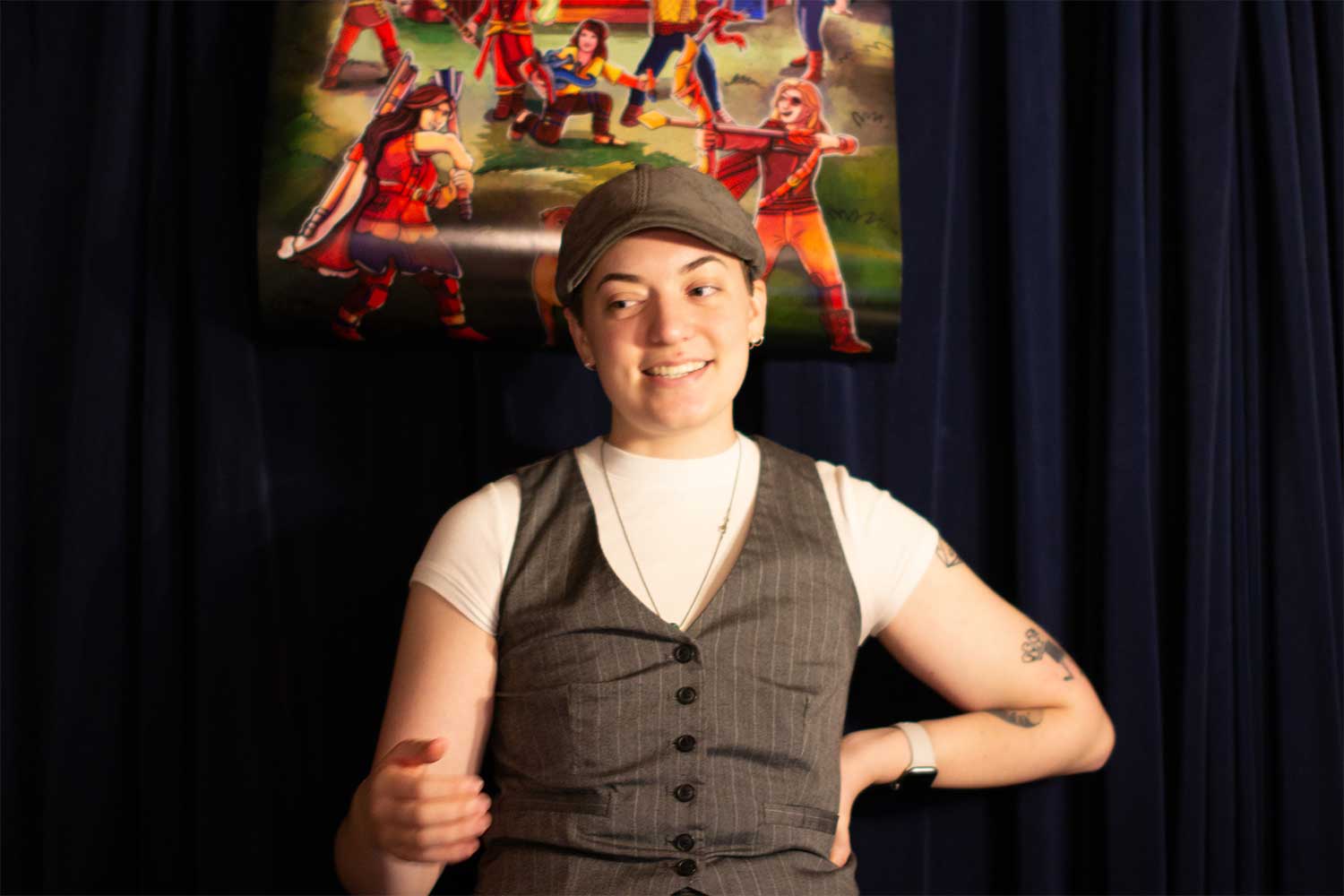
…The Adventure Begins…
We open in Eugene, Oregon. Well, medieval Eugene, Oregon.
A small red shack stands alone on Lincoln Street, backlit by the glow of dawn. Inside, a team dedicated to the production of the city’s broadsheet is discussing what to print the following Thursday. It is a crisp, cool day, interrupted only by the occasional visitor, asking for news about town. As the team sits at their respective desks, scratching away at pieces of parchment, the air ripples before bursting with bright light. The shimmer produces a single, unassuming scroll. It hangs in midair, awaiting acknowledgement.
JJ, the office barbarian1, is the first to move, taking the scroll and giving it a once over. (Roll an Investigation check.) Her eyes widen. It’s an editorial tip, and an unclear one at that. She hand delivers it to Camilla, the ranger2-in-chief, and Jody, madam sorcerer3, for review.
Camilla, scanning the wording of the message in depth, notes that the first letter of every sentence spells out A-R-C-I-M-O-T-O. Arcimoto? The rest of the note seems unrelated. The only way to confirm the tip is to follow its clues.
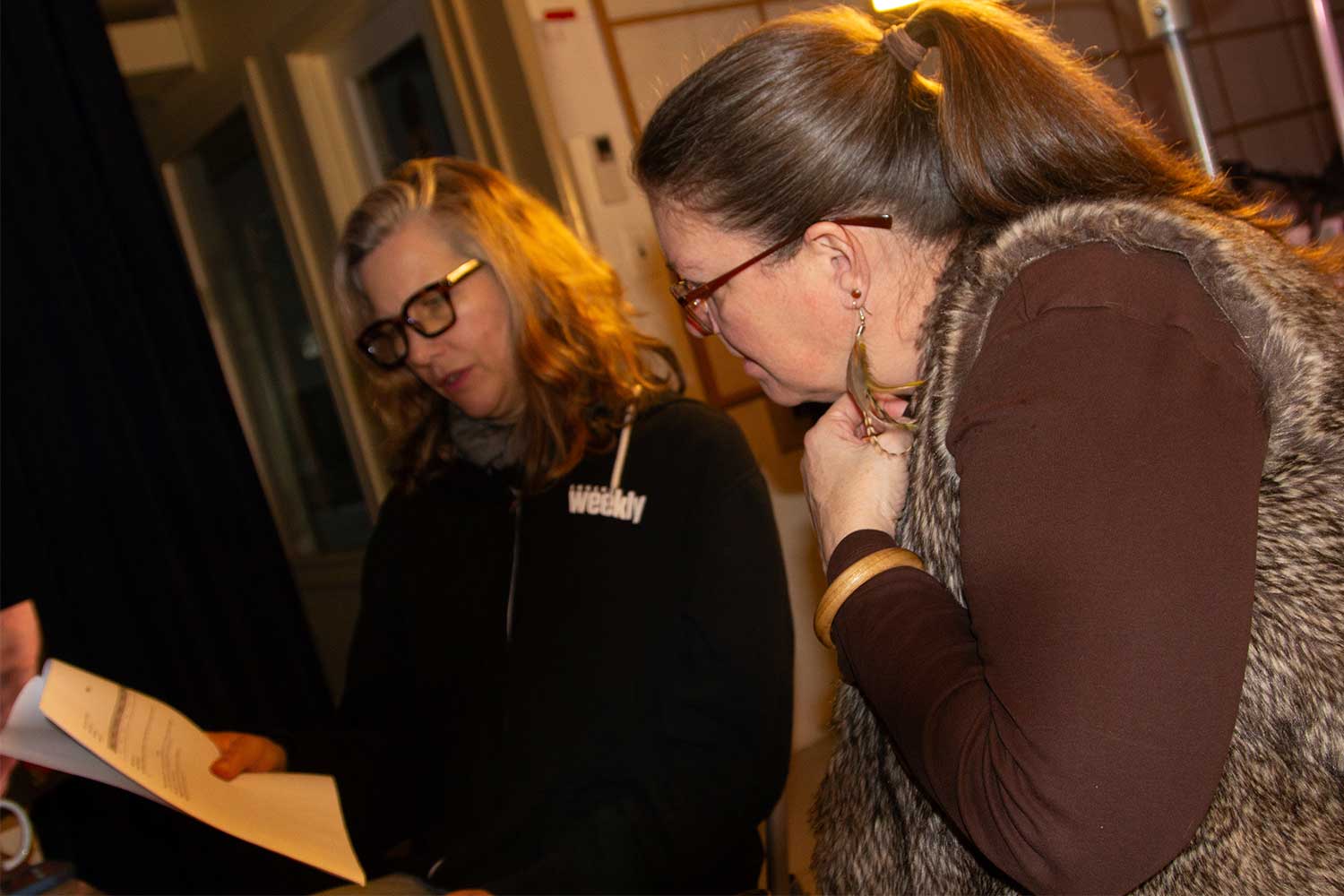
As they plan to head to the Whiteaker neighborhood, a three-wheeled cart pulls up out front. A well-dressed figure steps out and approaches the building, slamming open the door.
“Uh… JJ?” McKenzie, the art druid4, calls out. “Someone’s at the door.”
JJ hurries out of her office, ready to welcome a visitor or, if necessary, intercept a threat. The man in the lobby is towering and thin, a scarecrow of a person. He blots out the light as he lingers in the doorway. “Who can I speak to about the future of Eugene Weekly?” he asks.
An unfamiliar interloper in the Eugene Weekly lobby? This is a problem for Camilla.
“Yes, you can speak to me,” she says, holding out her hand for a shake. He frowns down at her hand, leaving it untouched.
“Is Bob not available to speak to?”
Camilla narrows her eyes at him as JJ, Jody and McKenzie brace against the man’s callous misogyny. As Camilla continues to impress upon him her authority, the room bristles, awaiting action. But who will move first? The room fills with tension and Jody, suspicious, takes a second look at what she first perceived to be a man. (Roll a Perception check.) His visage is flickering like an illusion. This isn’t a man at all. This is something much worse.
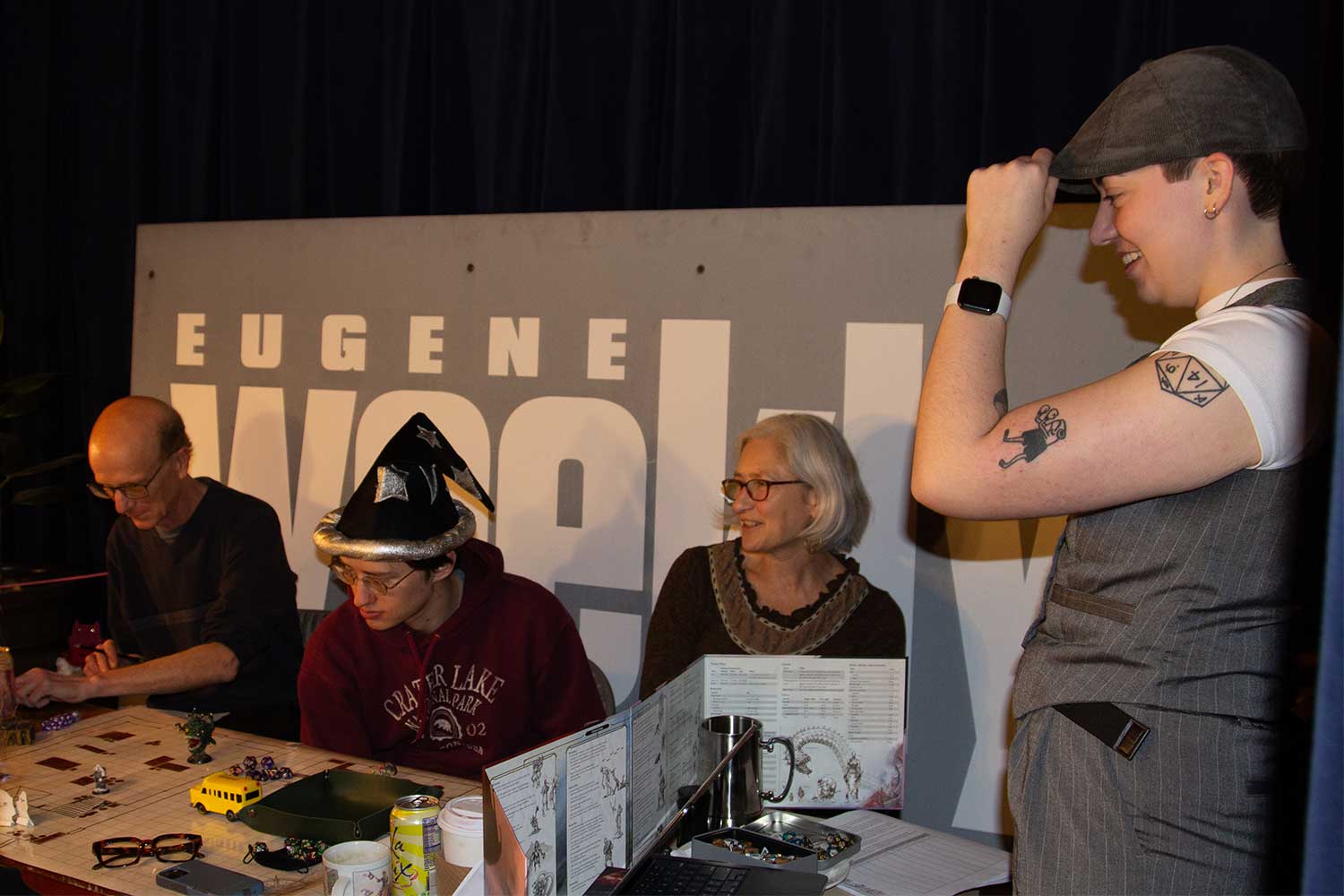
…Let’s Fight…
“Attack,” Jody yells. “Defend the Weekly!” (Roll for Initiative.)
JJ is the first to act, pinning the man against the wall as McKenzie swiftly transforms into a raven and divebombs him, shocking him out of his illusion once and for all. Towering over the office is a tentacled eyeball dripping with slime. A spectator has arrived at the Weekly.
(As is the case with most D&D sessions, that escalated rather quickly.)
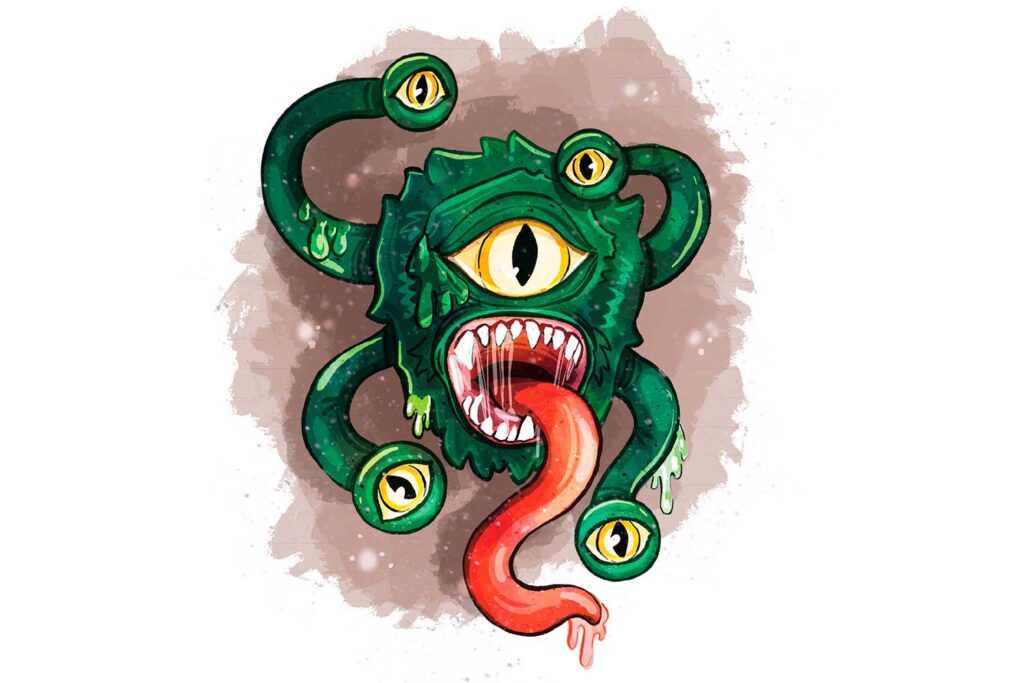
Spectator
Creature Type: Lesser Beholder
A medium-sized neutral-evil monster with a gaping maw, a central eye and four tentacles with eyeballs at the end. Each eye stalk emits a different harmful ray.
While this office doesn’t normally host combat, this is turning out to be a very abnormal day. The ruckus has called the rest of the office down upon the creature, and as he struggles against JJ, Bentley, the news warlock5, emerges from the cavern in the back he calls his office.
“Hey, what the hell guys, I’m trying to writ —” His eyes widen as he sees the struggle. Pulling his drinking horn from where it rests at his side, Bentley takes a deep gulp of something that smells suspiciously like very strong mead. His eyes focus as the magical drink powers him up.
“ELDRITCH BLAST,” he bellows. (Note from the DM: You don’t actually have to yell the name of your spell.) Still, the effect is the same as it slams into the spectator, damaging its giant, glossy eyeball.
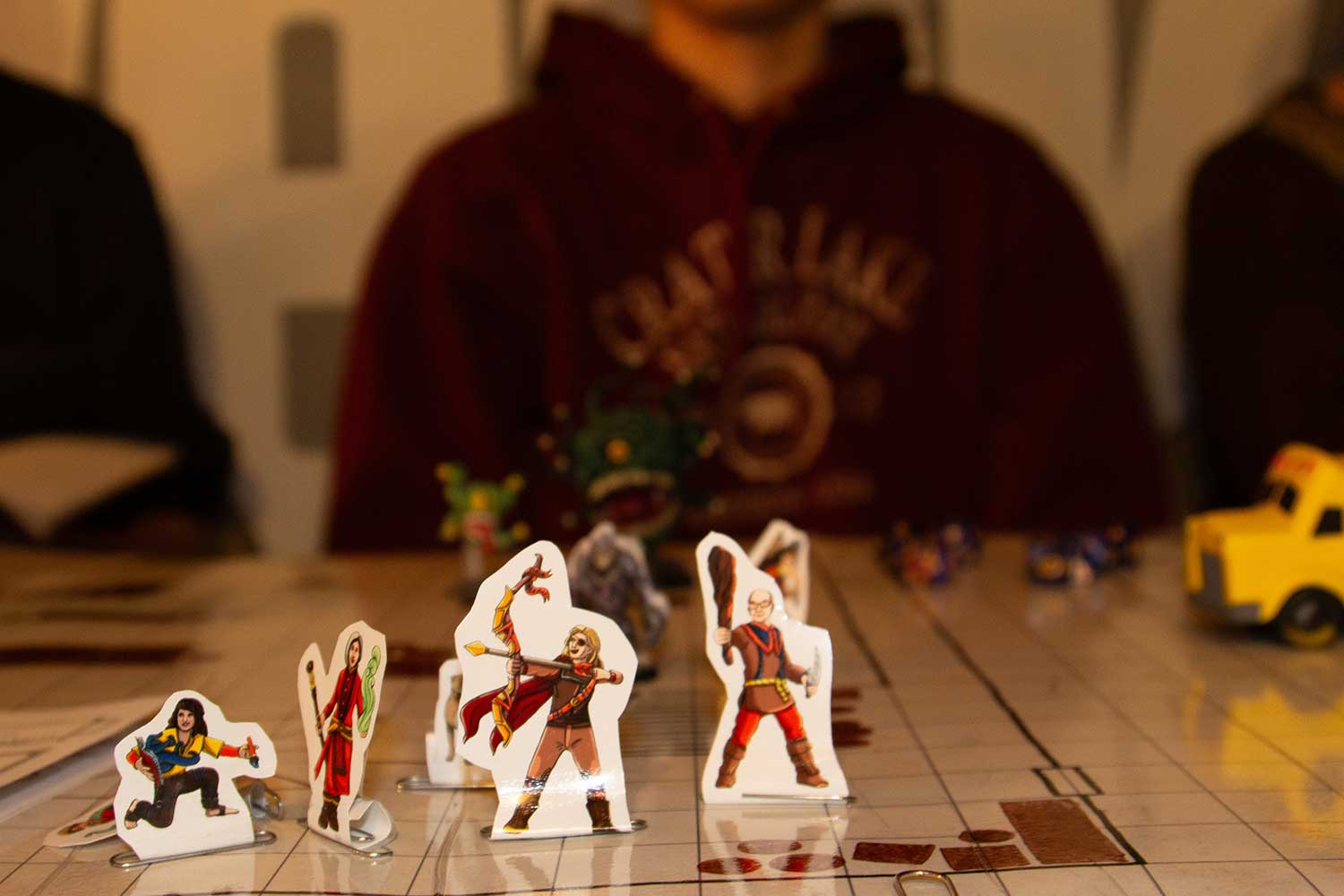
It’s Dan’s turn to join the fray. The copy cleric6 walks into the room just in time to see Bentley’s attack and surmises that the eyeball is the largest threat. Powering up a spell of his own, Dan sends a blinding ray of energy at the creature. Just as it’s about to hit, the creature jostles against JJ’s grapple, causing the spell to ricochet back at Dan instead, blinding him in a cruel turn of events. (Dan rolled a one. Bad things happen when you roll a one.)
As the battle rages on, magic spells and weapon attacks pummeling the creature at every turn, it powers up the worst of its own abilities: a paralyzing eye beam. McKenzie falls limp under its gaze, transforming back into her human form as she slumps against its eye stalks. The tide is turning against the Weekly; No one is coming to save them.
Then, three burning rays of fire fly from the other side of the room, hitting the spectator and engulfing it in flames. Jody has dealt it the killing blow! McKenzie leaps from its back as she regains her movement and together the group recover in the ruined lobby of their building.
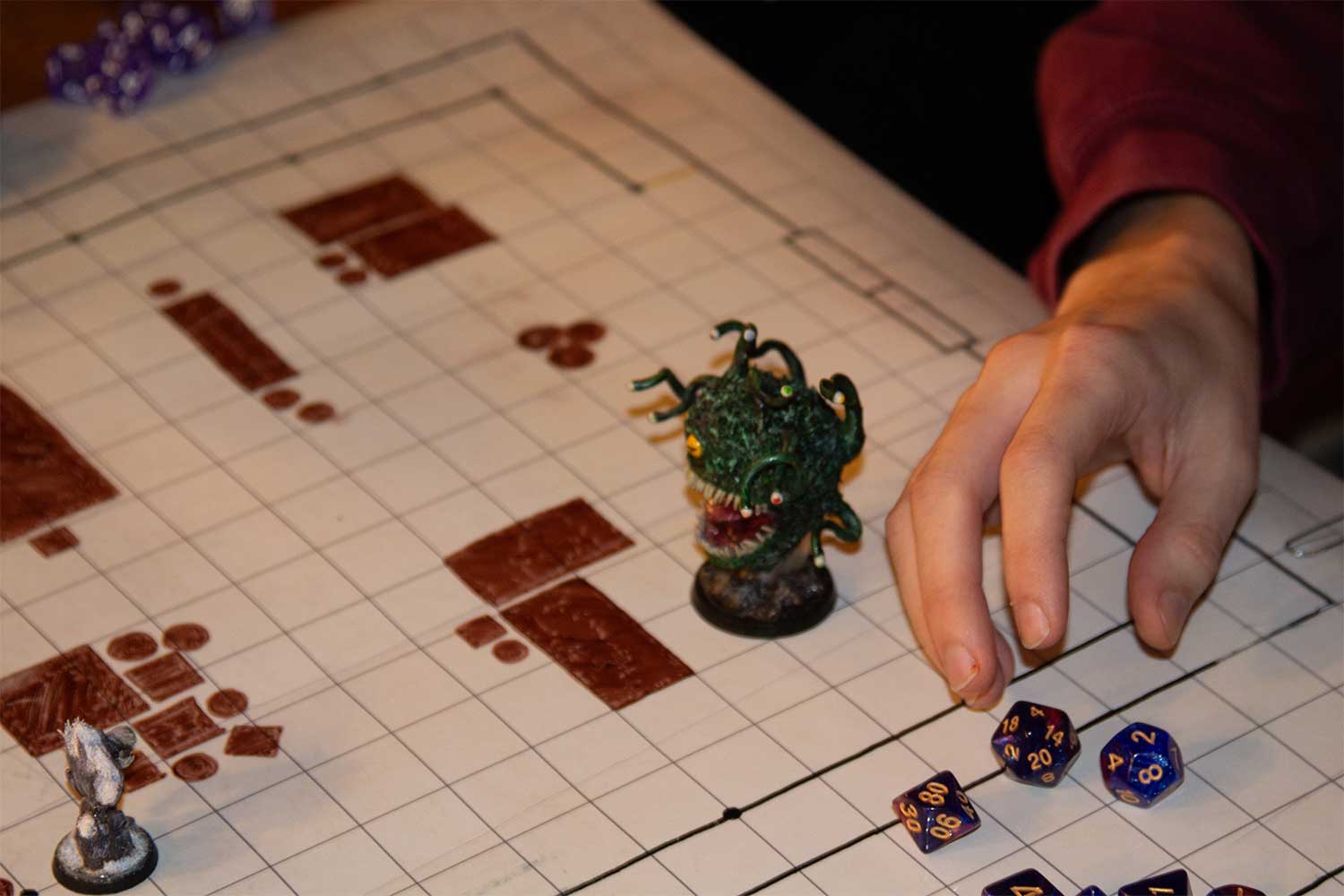
…Rallying Allies…
The group is left with more questions than answers as they survey the damage. And they still have that mysterious tip to follow up on. It seems the only course of action now is to belatedly ask the spectator its plans. (D&D is often “kill first, ask questions later,” much to the DM’s chagrin. Luckily, there’s a spell for that.)
Dan prepares to cast speak with dead7 on the creature. This spell must be used carefully, as a reanimated enemy will often speak in riddles and tricks. After much deliberation amongst the party, Dan casts the spell. The creature lifts from the ground, its deathly pallor remaining but its body now filled with just enough temporary life to cough up answers.
“Who do you work for?” Dan asks.
“The Harbinger,” the creature breathes.
“What is the Harbinger?”
“One who beholds all.”
“How do we defeat him?”
“He cannot fight what he cannot see.”
“When will he arrive?”
“Tomorrow morning.”
“Where will he arrive?”
“The warehouse in Whiteaker.”

The Harbinger
Creature Type: Beholder
A large, evil monster with a gaping maw, a central eye and an array of tentacles with eyeballs at the end. Each eye stalk emits a different harmful ray. Illustration by McKenzie Young-Roy.
The tip! The spectator and the mysterious tip were connected after all. With its five questions answered, the creature falls limp on the floor. But the party has gotten the clues they seek. (Against all odds. “Speak with dead” can be a tough spell.)
While JJ sweeps up glass and Camilla feeds the body of the creature to Biggie Pitbull, Bentley slips out of the door, unnoticed. He soon finds himself at the mayor’s home. (Roll a Charisma check.) She answers the door and, seeing the frantic look on his face, allows him inside to hear his plight.
Bentley relays the threat facing the city to the mayor, referring to it as an “eldritch horror,” the likes of which have never been seen. (Roll a Persuasion check.) The mayor is so moved by Bentley’s pleas for assistance that, rather than call in the cavalry, she decides to join them in their battle personally.
…Saving the Day…
The following dawn, everyone — including the mayor, who arrived on foot — reunites outside the abandoned Arcimoto factory. The dusty, yellowed windows are boarded up, but Jody spots movement inside. The group of seven (and Biggie) sneak in through a side entrance.
They rush into the darkened, cavernous space, spellcasters charging up their powers, JJ brandishing her mace and McKenzie kneeling to make a quick piece of art.
The Harbinger cackles as the party shows themselves; he rises above the dusty crates, revealing himself to be a beholder. (Classic D&D villain.)
Dan rushes into battle with a slightly scrambled rallying cry: “You live only once!”
Chanting “YLOO,” the party charges after him.
In the course of six seconds, JJ launches a javelin into the beholder’s central eye as Dan attempts his blindness spell once more. Success! Camilla sinks an arrow into one of the outer eye stalks and orders Biggie into battle. McKenzie completes her drawing — a grotesque half-panther-half-squid. The sketch, imbued with magic, allows her to wild shape8 into this form. Pulling back 20 feet, she pounces at the creature, backflipping to reveal her squid legs (DM Tip: Let your players have fun with descriptions. Otherwise, we would never have learned that the cat’s butt transferred over despite the tentacle-y lower half) and thwapping the beholder in the eyeball.
The Harbinger bites blindly at McKenzie (Gotta admit, it feels weird calling her McKenzie when she’s a half-panther-half-squid.), ripping off a tentacle.
The mayor casts enlarge9 on JJ, doubling her in size. JJ big, and JJ big mad. Coordinating with Jody and her fiery prowess, JJ deploys her mace — get it? — in a color spray10 through the blaze, creating a makeshift flamethrower.
The Harbinger shakes off his blindness and restraints, rising once more to shoot its death ray at the mayor. Bentley, who got her into this mess, dives in front of the oncoming ray, preventing the mayor from taking any damage. (Take care of your civil servants, folks. But, like, not with your body. Damn, Bentley.)
With Bentley down, and Camilla rushing to his side and providing him cover with her bow, JJ surveys the scene. The people of Eugene Weekly are tired, but JJ is huge. Her mace, set ablaze by the flagrant misuse of two melee weapons combined, serves as a fiery cudgel.
Thus, she beats the Harbinger, so thoroughly defeated, into a paste.
The party — and the mayor — take in the dilapidated warehouse, now stripped of evil. Today, they have saved the city with their magical and martial expertise; tomorrow, they will save it with local news.
Although people aren’t battling tentacled beasts with flaming weaponry in reality, the act of storytelling — of exaggerating and extrapolating on our own lives into the realm of fantasy — transforms information processing into a form of play.
“In modern environments, storytelling is more of a play activity than a learning activity,” Sugiyama says. “It’s a combination of learning through direct experience and then sharing your experiences with others.”
That being said, roll for initiative.
Any similarities between characters in the story to real life individuals are purely coincidental. Except for the mayor. She was based on Mayor Kaarin Knudson.
D&D: A Brief History
The fantasy roleplaying game — the first of its kind — spawned from the minds of game designers Gary Gygax and David Arneson in 1974. Dungeons and Dragons was published the same year by the company Tactical Studies Rules, which Gygax co-founded.
When the Satanic Panic struck the brittle hearts of Americans in the 1980s, D&D was accused of teaching witchcraft and paganism to youth. The playing of the tabletop roleplaying game (TTRPG) was deemed taboo, but nerds are nothing if not resilient.
Wizards of the Coast, a subsidiary of toy company Hasbro, purchased D&D from Tactical Studies Rules in 1997. In 2008, a whole new world of actual play podcasts — where people played TTRPGs for an audience — spawned with the creation of the Acquisitions Incorporated podcast. In 2014, Wizards of the Coast released the 5th edition ruleset, making the complicated game more accessible than ever. In 2015, a friend group of voice actors started Critical Role, which has grown to become the most successful actual play podcast and has since produced its own animated show on Amazon, Legends of Vox Machina.
Out of the ashes of President Donald Trump’s first term and the isolating effect of a global pandemic came a resurgence in people’s desire for fantasy. Suddenly, some sit-down escapism, where you could defeat the evil threatening your world, was rather appealing.It was appealing to us at Eugene Weekly, too.
D&D in the Media
Dungeons & Dragons has permeated media since its inception in 1974. Its Gothic horror reputation and subsequent cult following made it a go-to reference for everything from television to film to the YouTube and Twitch scene.
While D&D has long been popular amongst the nerdiest of us, Stranger Things, a Netflix show that began airing in 2016 and is approaching its final season, brought D&D back to the forefront of the public zeitgeist. It explored the prevailing view of D&D in the ’80s as a game kids loved and parents didn’t understand and often utilizes classic D&D villains (see: Vecna) in its main stories.
We would absolutely be remiss to skip over the importance of indie podcast creators like Critical Role and Dimension 20 who have utilized D&D’s Open Game License, allowing them to use content originally created by Wizards of the Coast, in their own productions and merch. Combined, this surge in media awareness of D&D brought us a feature-length film in 2023: Dungeons and Dragons: Honor Among Thieves. The film brought together all of the best parts of its titular game: quirky characters with tragic backstories, iffy magical systems and dumb sex jokes. Long-time fans of the game praised Honor Among Thieves for not taking itself too seriously while casual viewers began to search for groups to play with. Those of us sitting in the theatre felt the shift — D&D has reached an almost cool status. Gone are the demon rumors —the stories are here to stay.
Footnotes
- Barbarian — One who fights with weaponry and rage rather than magic and tricks. ↩︎
- Ranger — One who is skilled in tracking and fighting alongside natural beasts. ↩︎
- ↩︎
- Druid — One who is so in tune with nature that they can transform into the very creatures they covet. ↩︎
- Warlock — One who made a pact with an ancient being in order to gain power. ↩︎
- Cleric — One who practices the healing arts, often aided by their deity. ↩︎
- Speak with dead — Clerics can briefly revive deceased creatures to ask five questions. However, the creature must still have a functioning mouth. ↩︎
- Wild shape — Druids are able to use Wild Shape to transform into a creature they have seen before at will. ↩︎
- Enlarge — A creature doubles in size, as does their weaponry. ↩︎
- Color spray — A 15-foot cone of bright lights shoots forth, blinding a creature for a round (or 6 seconds). ↩︎
